Antioxidant polyphenol-rich extracts from the medicinal plants Antirhea borbonica, Doratoxylon apetalum and Gouania mauritiana protect 3T3-L1 preadipocytes against H2O2, TNFα and LPS inflammatory mediators by regulating the expression of superoxide dismutase and NF-κB genes
- PMID: 25685071
- PMCID: PMC4329220
- DOI: 10.1186/s12950-015-0055-6
Antioxidant polyphenol-rich extracts from the medicinal plants Antirhea borbonica, Doratoxylon apetalum and Gouania mauritiana protect 3T3-L1 preadipocytes against H2O2, TNFα and LPS inflammatory mediators by regulating the expression of superoxide dismutase and NF-κB genes
Abstract
Background: Adipose cells responsible for fat storage are the targets of reactive oxygen species (ROS) like H2O2 and pro-inflammatory agents including TNFα and LPS. Such mediators contribute to oxidative stress and alter inflammatory processes in adipose tissue, leading to insulin resistance during obesity. Thus, the identification of natural compounds such as plant polyphenols able to increase the antioxidant and anti-inflammatory capacity of the body is of high interest. We aimed to evaluate the biological properties of polyphenol-rich extracts from the medicinal plants A. borbonica, D. apetalum and G. mauritiana on preadipocytes exposed to H2O2, TNFα or LPS mediators.
Methods: Medicinal plant extracts were analysed for their polyphenol contents by Folin-Ciocalteu and UPLC-ESI-MS methods as well as for their free radical-scavenging activities by DPPH and ORAC assays. To assess the ability of polyphenol-rich extracts to protect 3T3-L1 preadipocytes against H2O2, TNFα or LPS mediators, several parameters including cell viability (MTT and LDH assays), ROS production (DCFH-DA test), IL-6 and MCP-1 secretion (ELISA) were evaluated. Moreover, the expression of superoxide dismutase, catalase and NF-κB genes was explored (RT-QPCR).
Results: All medicinal plants exhibited high levels of polyphenols with free radical-scavenging capacities. Flavonoids such as quercetin, kaempferol, epicatechin and procyanidins, and phenolic acids derived from caffeic acid including chlorogenic acid, were detected. Polyphenol-rich plant extracts did not exert a cytotoxic effect on preadipocytes but protected them against H2O2 anti-proliferative action. Importantly, they down-regulated ROS production and the secretion of IL-6 and MCP-1 pro-inflammatory markers induced by H2O2, TNFα and LPS mediators. Such a protective action was associated with an increase in superoxide dismutase antioxidant enzyme gene expression and a decrease in mRNA levels of NF-κB pro-inflammatory transcription factor.
Conclusion: This study highlights that antioxidant strategies based on polyphenols derived from medicinal plants tested could contribute to regulate adipose tissue redox status and immune process, and thus participate to the improvement of obesity-related oxidative stress and inflammation.
Keywords: Antioxidant strategies; Inflammation; Obesity; Oxidative stress; Plant polyphenols.
Figures
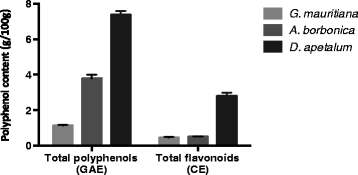
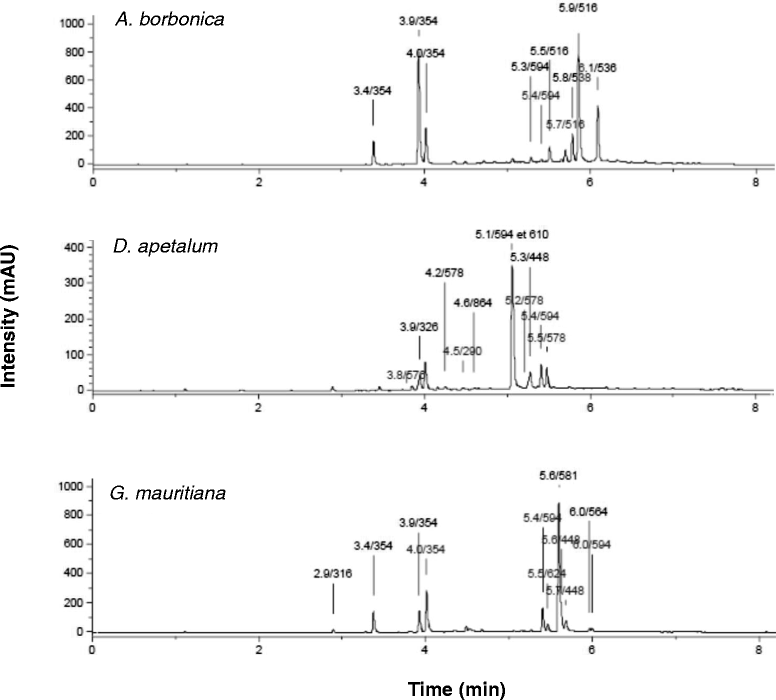

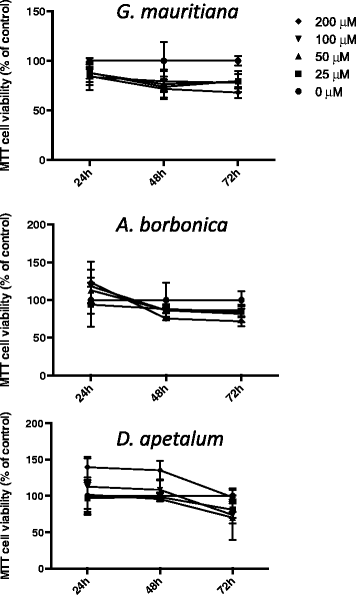
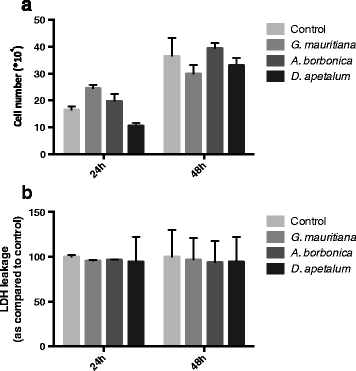
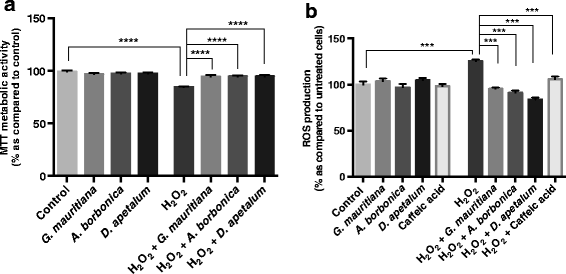
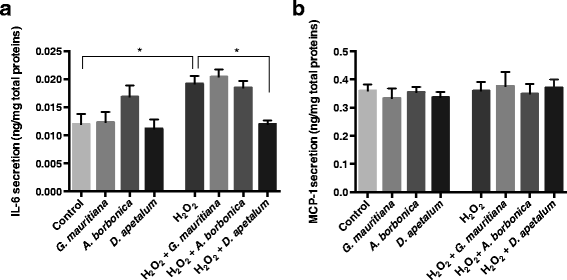
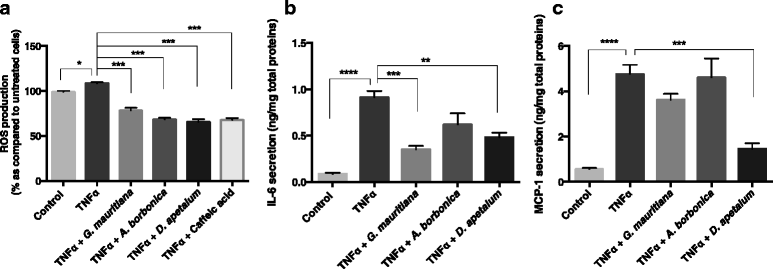
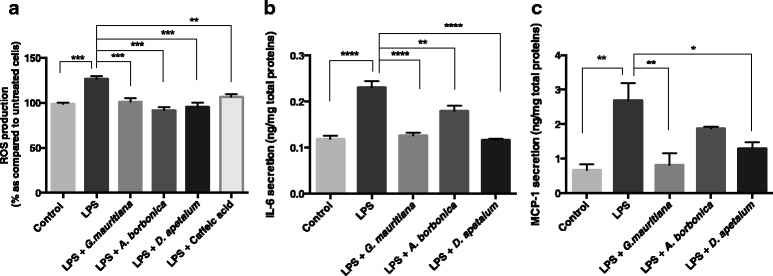

Similar articles
-
Anti-inflammatory and antioxidant effects of polyphenols extracted from Antirhea borbonica medicinal plant on adipocytes exposed to Porphyromonas gingivalis and Escherichia coli lipopolysaccharides.Pharmacol Res. 2017 May;119:303-312. doi: 10.1016/j.phrs.2017.02.020. Epub 2017 Feb 27. Pharmacol Res. 2017. PMID: 28249816
-
Antioxidant and Cytoprotective Properties of Polyphenol-Rich Extracts from Antirhea borbonica and Doratoxylon apetalum against Atherogenic Lipids in Human Endothelial Cells.Antioxidants (Basel). 2021 Dec 24;11(1):34. doi: 10.3390/antiox11010034. Antioxidants (Basel). 2021. PMID: 35052538 Free PMC article.
-
Evaluation of antioxidant properties of major dietary polyphenols and their protective effect on 3T3-L1 preadipocytes and red blood cells exposed to oxidative stress.Free Radic Res. 2014 Apr;48(4):387-401. doi: 10.3109/10715762.2013.879985. Epub 2014 Jan 26. Free Radic Res. 2014. PMID: 24393006
-
Comparison of in vitro tests for antioxidant and immunomodulatory capacities of compounds.Phytomedicine. 2014 Jan 15;21(2):164-71. doi: 10.1016/j.phymed.2013.08.008. Epub 2013 Sep 14. Phytomedicine. 2014. PMID: 24041614 Review.
-
Total polyphenols and bioactivity of seeds and sprouts in several legumes.Curr Pharm Des. 2013;19(34):6112-24. doi: 10.2174/1381612811319340005. Curr Pharm Des. 2013. PMID: 23448441 Review.
Cited by
-
Protective effects of Phyllanthus phillyreifolius extracts against hydrogen peroxide induced oxidative stress in HEK293 cells.PLoS One. 2018 Nov 16;13(11):e0207672. doi: 10.1371/journal.pone.0207672. eCollection 2018. PLoS One. 2018. PMID: 30444889 Free PMC article.
-
Bioactive Natural Compounds with Antiplatelet and Anticoagulant Activity and Their Potential Role in the Treatment of Thrombotic Disorders.Life (Basel). 2021 Oct 15;11(10):1095. doi: 10.3390/life11101095. Life (Basel). 2021. PMID: 34685464 Free PMC article. Review.
-
Antioxidant Polyphenols of Antirhea borbonica Medicinal Plant and Caffeic Acid Reduce Cerebrovascular, Inflammatory and Metabolic Disorders Aggravated by High-Fat Diet-Induced Obesity in a Mouse Model of Stroke.Antioxidants (Basel). 2022 Apr 27;11(5):858. doi: 10.3390/antiox11050858. Antioxidants (Basel). 2022. PMID: 35624723 Free PMC article.
-
Unveiling Antimicrobial and Antioxidant Compositional Differences between Dukkah and Za'atar via SPME-GCMS and HPLC-DAD.Molecules. 2022 Oct 1;27(19):6471. doi: 10.3390/molecules27196471. Molecules. 2022. PMID: 36235006 Free PMC article.
-
Bioprospecting the Curculigoside-Cinnamic Acid-Rich Fraction from Molineria latifolia Rhizome as a Potential Antioxidant Therapeutic Agent.Molecules. 2016 Jun 17;21(6):682. doi: 10.3390/molecules21060682. Molecules. 2016. PMID: 27322226 Free PMC article.
References
LinkOut - more resources
Full Text Sources
Other Literature Sources
Miscellaneous

